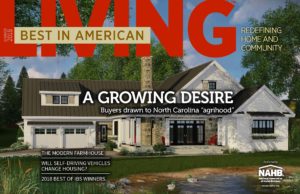By Susan Bady
What will residential communities look like after the COVID-19 pandemic subsides? While sweeping changes aren’t likely, architects, planners, and developers believe we’ll see a greater emphasis on remote working opportunities; safer ways to socialize; appealing amenities; and in general, creating places where people really want to be.
“I think there will be renewed appreciation for things we already have, particularly outdoor spaces that allow us to interact without making physical contact—specifically the front porch,” says Don Powers, AIA, CNU, LEED AP, founder and president of Union Studio Architecture & Community Design in Providence, R.I.
Powers notes that at the turn of the 20th century, the front porch was the primary gathering place in the summer. “People would walk by and you could talk to them from behind your porch railings,” he says. “The front porch, as a device, is a great way to recognize that maybe we don’t want to get together as much as we used to.”
Another innovation, the sleeping porch, also appeared in the early 20th century. Sleeping porches were built in many Queen Anne Victorian and Arts & Crafts-style houses of the period as a respite from hot summer weather. These screened-in porches were usually located on the second or third floor and were open on two or more sides to catch evening breezes. At the time, tuberculosis was the number-one cause of death in the United States, and fresh air was considered the best treatment for TB sufferers. Sleeping porches still exist in some older homes, and clients have even requested them for new custom homes.
Before automobiles, says Powers, Americans knew how to achieve the correct balance of being part of a community and being in their private realm. The front porch, as previously mentioned, functioned as a social connector to neighbors and visitors passing by. Once automobiles came along, homeowners began entering from the rear where the garage was located, and lifestyles shifted to the backyard.
He thinks the pendulum will swing back, and we are going to rediscover the street and the porch as an outdoor room. “When you’re on the front porch, you’re not in the street, but you’re not in the house,” he says. “You’re in a protected, semi-private space.”
Balancing community and privacy
Powers recognizes one of the serious struggles of the COVID-19 quarantine: isolation. Humans are social animals, and without being able to gather in large groups, they feel cut off, especially if they live in homes without front porches.
Some community-planning concepts are better suited to a post-COVID future, Powers says, specifically New Urbanism. “The movement has always been about re-forming the way we make communities to prioritize that kind of public and semi-public world, as opposed to the way that we, in the past 50 years, have de-prioritized it [by sending] everybody to the patio or backyard.”
New Urbanist developments, which are purposely designed and built to create a sense of community, offer intentional gathering spaces but also plenty of opportunities for accidental interaction. “Streets cross and there are sidewalks, not cul-de-sacs where nobody coming down the street is going to be from a different neighborhood,” he says. “With the pandemic, there are now more reasons than ever to plan communities that encourage safe interaction.”
Even multifamily buildings can provide a high-quality outdoor environment, Powers says, by incorporating walking paths and trails; native plant materials; good-size trees; pocket parks; and community green space for residents.
Ken Ryan, principal of KTGY Architecture + Planning in Irvine, Calif., and head of the firm’s Community Planning and Urban Design Studio, thinks new community planning will focus on development that moves forward in smaller increments.
“A continued push for a variety of housing product and affordability will also be present with smaller homes,” says Ryan. “Some of these will be allowed with traditional single-family detached neighborhoods, where jurisdictions are now adopting bylaws such as horizontal apartments.” Products such as this, he says, maintain a reasonable density but allow residents to live in a single-family detached configuration that is more compatible and acceptable in certain established neighborhoods.
Working remotely will increase
While Powers doesn’t expect significant changes in community planning, he does foresee at least one permanent shift: more people will be working from home. “I don’t think we’re going to be fully remote once we get a chance to come back together, but I do think it’s going to be a bigger component of people’s lives.”
This could mean an evolution in the work-at-home environment as well as community design, which in the future might include more co-working spaces that are not necessarily a central office, he says.
Ryan agrees that post COVID-19 influences may result in a shift to remote working, along with enhanced technologies and a push to the suburbs. “Floor plans will need to accommodate flexible space for Zoom Rooms and a better working-at-home environment,” he says.
It’s clear to Powers that the housing industry must find a different way of designing homes and communities so that people can be together without making each other sick, “because it’s an absolutely human impulse to gather.”
Coming soon: part 2 of “Community Planning in a Post-COVID World,” with examples of what that looks like now and in the immediate future.
Post by Sue Bady, self-proclaimed “armchair architect” and advocate of sustainability, new building technology and most of all, good design.
Header image: Summit Sky Ranch, 2020 BALA Winner, photo by Norris Design

